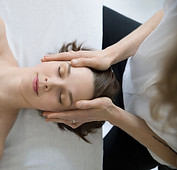top of page
Rakhee Mediratta
Osteopathy
Central & West London ~ Chalfont

Rakhee has helped over 5,000+ patients in 17 years
Registered Osteopath & Advanced Licensed Perrin Technique Practitioner in London & South East England
for Chronic Fatigue/ME & Fibromyalgia using The Perrin Technique
Rakhee Mediratta
Osteopathy
Central & West London ~ Chalfont

Craniosacral Therapy London
What is Craniosacral Therapy?
Cranial or Craniosacral Therapy is a form of osteopathy used by some practitioners who have undertaken further training in this specific field. This technique is used to determine a clinical diagnosis of stressors in the body and is in the form of a manual treatment; as are all osteopathic practices. Craniosacral therapy is an effective supportive treatment for post-viral fatigue, CFS / ME, Fibromyalgia, Lyme Disease, headaches, migraines, cognitive problems including brain fog, concentration issues and memory loss, head pressure, trigeminal neuralgia, small fibre neuropathy, bells palsy, pelvic pain, sciatica, muscle spasms, tension and inability to relax and pregnant women, babies and children. It has also been found to be beneficial to those suffering from stress, anxiety or psychological trauma. Many people find it valuable as an ongoing support to their busy lives and helping in the management of life's many challenges. Whether these stressors are as a result of physical injury, infection, disease or emotional factors, it is acknowledged that all traumas and tensions leave their mark on the body and are held in the body's tissues in the form of restriction or constriction of some kind.
.jpg)


How does Craniosacral Therapy work?
William Garner Sutherland originally developed Craniosacral Therapy in 1899 when he identified movement between the bones of an adult skull (the cranium). He experimented with different mechanisms to compress individual cranium bones which he found stimulated movement in specific areas of the head and discovered strong mental and physical reactions in his patients as well as identifying a deep regular rhythm inside the cranium of each of these patients. It is this rhythm which forms the basis of the Craniosacral treatment; the treatment stimulates and influences the cranial rhythm which in turn influences the correct movement of the fluid in the lymphatic system and different tissues around the body. It is important to keep the blood, lymphatic system and cerebrospinal fluid moving properly in order to eliminate toxins and waste products in order to have the ability to absorb nutrients efficiently.
.jpg)
What happens during the treatment?
During the treatment, the practitioner is able to assess and recognise any areas that may be restricted and whether the quality of the cranial rhythm is disturbed. The osteopath is able to detect these things using his or her hands and applying very gentle pressure on the head and neck areas. The movement is of such small magnitude, it takes practitioners who are highly skilled in cranial work to assess and detect it. They are then able to stimulate and alter the cranial rhythm, with gentle pressure, so that it will work more effectively. Over time with this treatment, patients’ rhythms return to a normal rate so that the flow of fluid is no longer disrupted, thereby calming the nervous system, reducing physical, mental and emotional stress, decreasing muscle pain, rebuilding energy levels and alleviating other symptoms in order to improve quality of life.



What will happen during the consultation?
The initial consultation is 60 minutes long and involves taking a full case history where we will discuss how your condition impacts you and affects your life and a 30-minute treatment. A full physical examination will be completed and then a diagnosis can be given for your condition. We will discuss how the treatment works, the research that supports this treatment approach as well as a prognosis and an out-line for the tailored follow up treatment plan to improve your quality of life and support you during the recovery process.
Opening Hours
Copyright © Rakhee Mediratta. All rights reserved. Cookie & Privacy Policy
bottom of page



